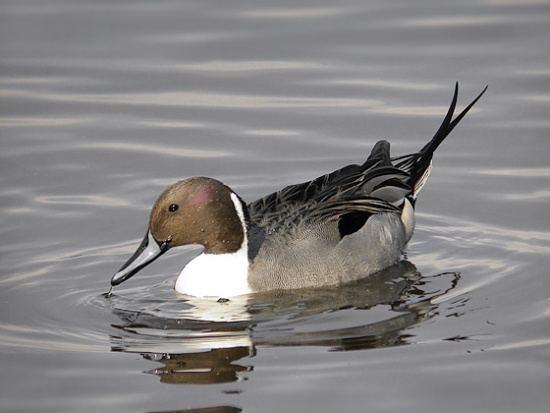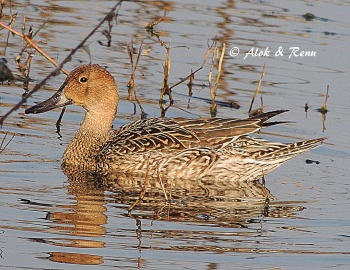Aloktewari (talk | contribs) (Image of immature added.) |
Aloktewari (talk | contribs) (Image of female added) |
||
| Line 2: | Line 2: | ||
;[[:Category:Anas|Anas]] acuta | ;[[:Category:Anas|Anas]] acuta | ||
==Identification== | ==Identification== | ||
| − | [[Image:northern_pintail_alok.JPG|thumb|350px|right|Immature Male(left) with adult <br />Bharatpur, Keoladeo | + | [[Image:northern_pintail_alok.JPG|thumb|350px|right|Immature Male (left) with adult <br />Bharatpur, Keoladeo National Park, [[India]], Dec-2015<br />Photo by {{user|aloktewari|Alok Tewari}}]] |
65 to 75 cm (25½-29½ in) in length, while females are smaller at 50 to 55 cm (19¾-21¾ in). | 65 to 75 cm (25½-29½ in) in length, while females are smaller at 50 to 55 cm (19¾-21¾ in). | ||
*Pale grey bill with black stripe down centre | *Pale grey bill with black stripe down centre | ||
| Line 15: | Line 15: | ||
**White rear border and chestnut forward border | **White rear border and chestnut forward border | ||
====Similar Species==== | ====Similar Species==== | ||
| + | [[Image:northern_pintail_female.JPG|thumb|350px|right|Female<br />Bharatpur, Keoladeo National Park, [[India]], Jan-2013<br />Photo by {{user|aloktewari|Alok Tewari}}]] | ||
*Although female may look like female [[Mallard]], you can tell the difference by the missing teal section in the back of the bird. | *Although female may look like female [[Mallard]], you can tell the difference by the missing teal section in the back of the bird. | ||
Revision as of 07:36, 1 December 2016
- Anas acuta
Identification

Bharatpur, Keoladeo National Park, India, Dec-2015
Photo by Alok Tewari
65 to 75 cm (25½-29½ in) in length, while females are smaller at 50 to 55 cm (19¾-21¾ in).
- Pale grey bill with black stripe down centre
- Dark brown head
- White neck, breast and belly
- White finger extending up back of neck to rear part of face
- Grey flanks and back with black centres to back feathers
- Whitish patch at rear portion of flanks bordering undertail coverts
- Black undertail coverts
- Long, black central tail feathers
- Green speculum
- White rear border and chestnut forward border
Similar Species
- Although female may look like female Mallard, you can tell the difference by the missing teal section in the back of the bird.
Distribution
Iceland, Northern Europe, Russia, China, North America, and Canada. Common on most lakes.
Taxonomy
This is a monotypic species[1].
Isolated southern populations of pintails from Kerguelen (eatoni) and the Crozet Islands (drygalskii) are treated either as subspecies of Northern Pintail or as full species by some authorities[2].
Habitat
Breeds on freshwaters including flooded meadows, well-vegetated lakes or slow-flowing rivers.
Behaviour
Diet
It feeds by dabbling for plant food mainly in the evening or at night. Diet includes aquatic insects, mollusks and crustaceans as well as grasses and seeds in fields.
Breeding
The nest is a shallow scrape on the ground lined with plant material and down, in a dry location that may be fairly far from water.
Vocalisation
<flashmp3>Anas acuta (song).mp3</flashmp3>
Listen in an external program
References
- Clements, J. F., T. S. Schulenberg, M. J. Iliff, D. Roberson, T. A. Fredericks, B. L. Sullivan, and C. L. Wood. 2015. The eBird/Clements checklist of birds of the world: v2015, with updates to August 2015. Downloaded from http://www.birds.cornell.edu/clementschecklist/download/
- Avibase
Recommended Citation
- BirdForum Opus contributors. (2025) Northern Pintail. In: BirdForum, the forum for wild birds and birding. Retrieved 11 May 2025 from https://www.birdforum.net/opus/Northern_Pintail
External Links





